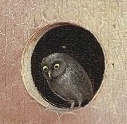








The focus for Wertheim Aymes interpretation of Bosch can be found in his Hieronymus Bosch, eine Einfuehrung in seine geheime Symbolik, Berlin and Amsterdam 1957.
"The present work makes use of the results of anthroposophical spiritual science because, at the present time, the concepts developed by Rudolf Steiner offer the only possible ideas for an appropriate modern interpretation of the subject-matter - the wisdom of the Rosicrucians, as presented by Hieronymus Bosch."Two decades later Clement A. Wertheim Aymes' The Pictorial Language of Hieronymus Bosch, was published. In the light of his earlier remark we might be tempted not to bother reading this book, but, giving the author a little rope we press on. Perhaps in the intervening period he might have abandoned his rather flimsy thesis and found something more solid. But in his Introduction we are faced with great disappointment. He says there,
"Bosch's great works cannot be regarded merely as ordinary paintings�. It will be shown that these paintings can be 'read'. They are then found to contain the teachings of a world philosophy which stems from the Rosicrucians, who developed a new cultural impulse for Europe and the West from about the middle of the fifteenth century."Is "fifteenth century" a misprint, a typo of the editor ? Sadly no! Wertheim Aymes, being a follower of the clairvoyant Steiner, believes this early date. The reality is that the first mention of Rosicrucians is in a manuscript of 1611, a century after Bosch's death. He emphasises the point.
"It has been shown with reasonable certainty by other scholars that Bosch was a Rosicrucian."Really ! That stretches the dictionary meaning of "reasonable certainty" beyond the point where pigs can readily become airborne.
"Bosch, the painter, was also a member of the illustrious Brotherhood of Our Lady, and belonged to the inner circle, where Rosicrucian ideas were familiar to the members."Really ! And I thought the Brotherhood of Our Lady was a conventional Catholic Confraternity, as recorded in its documents and accounts, but instead am now being asked to see these straight laced catholics as indulging in heretical Rosicrucian ideas.
"We find in The Chymical Wedding of Christian Rosenkreutz A.D. 1459, and the Fama Fraternitatis that, literally ' I.A. brought in a skiller painter 'B'. This painter 'B', could easily be Hieronymus Bosch."Really! Could this easily be so? But isn't the Chymical Wedding of Christian Rosenkreutz an allegorical novel published in 1616, and the Fama Fraternitatis a contrivance written a few years before it was published in 1614?
Wertheim Aymes interpretation of Bosch as a Rosicrucian, completely founders on his reading early 17th century allegorical fictions as true accounts from the 15th century. He blindly follows the clairvoyant nonsense of Steiner whose idea of history was deeply flawed by his wanting it to correspond to his contrived metaphysical ideas. To be charitable to Wertheim Aymes, he was writing in the period 1950-70 when there was not a mass of solid historical research on the Rosicrucian phenomenon available. Now some fifty years on, with the historical background to the Rosicrucian mythos intensively explored by scholars and traced back to its source manuscript and printed books and pamphlets, Wertheim Aymes suppositions cannot be sustained, and once again our porcine friends happily find themselves firmly set on their four feet again.
It is pointless reading this book as it is based on misunderstandings and false history.






